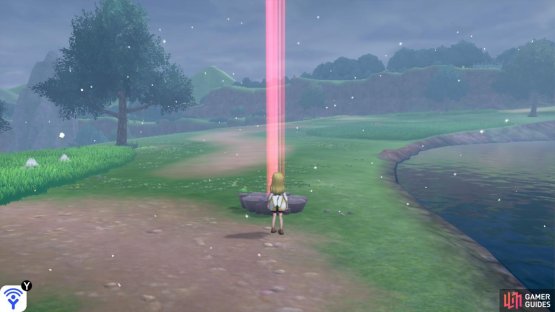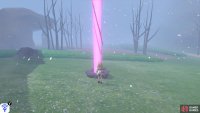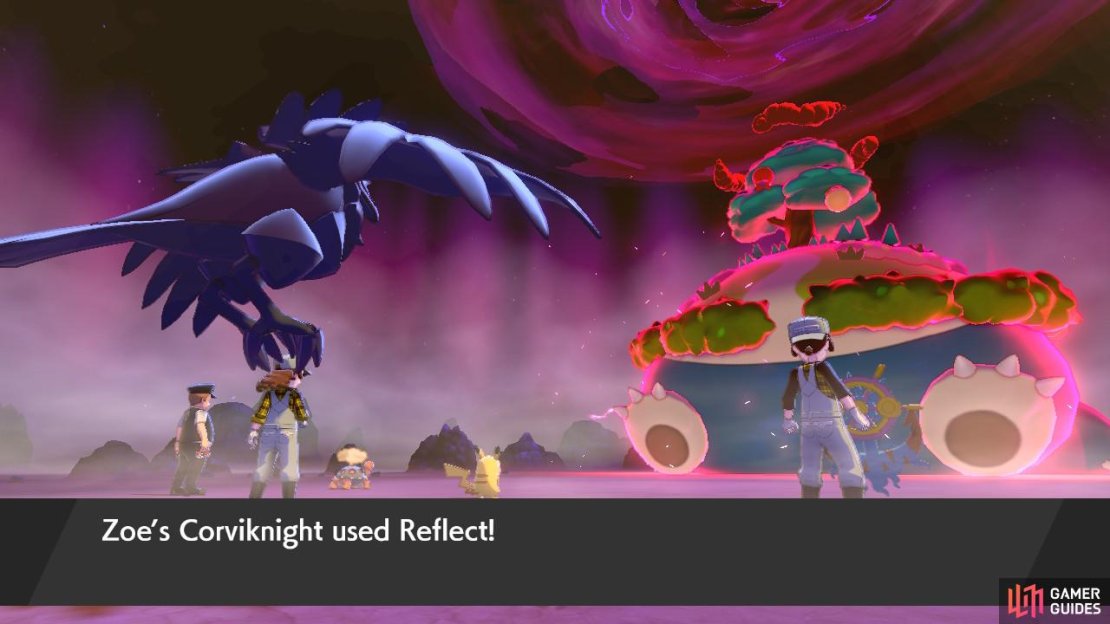These are a new type of battle where up to four players can team up to take down a powerful Dynamaxed Pokémon. After defeating the gargantuan foe, all players will have a chance to catch it.
Where to Find¶
(1 of 2) A common raid.
A common raid. (left), A rare raid. (right)
In general, Max Raid Battles can be found in the Wild Area. Specifically, the Pokémon Dens–the hexagonal rock structures–scattered all over the place. If there’s a beam of light coming from inside a den, that means a Max Raid Battle is available there.
Depending on the beam’s colour, the raid may be a common one (shown by a red beam) or rare one (shown by an ominous-looking purple beam). The rarity of the raid dictates the Dynamaxed Pokémon that may appear; common and rare raids each have a separate pool of possible Pokémon.
Max Raid Battles will spawn at the start of each day and they’ll be randomly distributed across all of the dens. New raids will also spawn if you manage to clear all of the existing raids. After a raid has spawned, it’ll stick around until midnight, after which it’ll disappear.
Starting a Raid¶
When you inspect a den, you’ll be shown the difficulty of the rare (where 5-stars is the hardest), plus the Dynamaxed Pokémon’s type(s) and silhouette. The victory and defeat conditions will also be displayed in the corner. Typically, the battle is lost if the battle exceeds 10 turns or a total of 4 Pokémon faint.
You can choose from the following options:
-
Invite Others: Pick this to let other players join your Max Raid Battle. You can invite other players locally or online (but not both). Anybody will be able to join your raid, but you can press the + Button to set up a private Link Code.
-
Don’t Invite Others: Don’t want to play with others? That’s fine! Choose this to begin the raid yourself, with 3 AI partners.
-
Switch Pokémon: By default, you’ll send out your first available Pokémon, but you can select this to choose any Pokémon from your party or boxes.
-
Quit: Leave the raid. You can always come back later.
If you choose to “Invite Others”, you’ll have 3 mins for the room to fill up. During this time, you can press “Ready to Battle!” to confirm your Pokémon choice, “Switch Pokémon” to change the Pokémon you send out or “Quit” to cancel looking for players. After readying, you can choose “Start a Battle” to begin the raid straight away. Any missing spaces will be filled with AI trainers.
To join somebody else’s raid, you need to use the Y-Comm. From here, select a “Seeking” stamp if there is one. To make things easier, you can set the stamp filter to “Seeking”. If no such stamps are available, you’ll have to wait. Once enough time’s passed, an X Button prompt will appear, allowing you to refresh the stamps.
Mechanics¶
Dynamaxing helps to speed up breaking shields.
During a raid, you and three other trainers (can be human and/or AI ones) can each choose an individual action to perform. The available actions are the same as normal battles, except picking “Pokémon” only lets you view your team’s Pokémon–you cannot switch during a raid. In the top-left corner, you’ll be able to see what kind of action your allies have chosen.
Dynamaxing is possible during a raid, but the way it works is slightly different. Firstly, the team can Dynamax multiple times, but only one player can Dynamax at a given time. When the raid starts, Player 1 will get a chance to Dynamax. If they do not Dynamax, Player 2 will get the chance on the 2nd turn and so forth. Finally, on the 5th turn, the opportunity will cycle back to Player 1.
As for your opponent, they will have a much, much bigger health bar than usual; their amount of health depends on the difficulty of the raid. Also, to even the odds, they can attack multiple times during one turn. On top of that, they may occasionally reset all favourable stat boosts and abilities on your team’s side, while clearing all negative effects on their side.
When the foe’s health reaches certain thresholds, they may raise a protective shield around them. This shield will greatly reduce the damage they receive, while protecting them from status conditions, stat-changing effects, as well as the secondary effects of Max Moves.
The shield can be removed by hitting the Pokémon a certain number of times, as indicated by the shield gauge. Max Moves will reduce the shield by 2 bars, while all other moves will reduce it by 1 bar. Damage doesn’t matter at all. Once the shield breaks, the Pokémon will lose some HP and have lowered defensive stats.
If your Pokémon faints, you’re not out of the game just yet. On your next turn, “Fight” will be replaced with “Cheer”, which has a chance of boosting your team’s stats or weakening the opponent’s shield. But there’s also a chance it’ll do absolutely nothing. The turn afterwards, your Pokémon will be revived with full health. That said, you don’t want to faint too many times or you’ll lose.
The Rewards¶
Successfully lower the Dynamaxed Pokémon’s health to 0 and you’ll be given the chance to catch it. However, you only get one chance, so make it count! If you host a non-event raid, the chance of catching the Pokémon is around 100%. However, if it’s an event raid or you’re a guest in a multiplayer raid, the chance can be much lower.
Even if you don’t manage to catch the Pokémon, you’ll still get a bunch of rewards, including experience candy, berries and TRs (Technical Records). But if you’re not happy, you can save before starting the raid, then reset if you fail to catch the Pokémon. Considering the rewards, it’s a very good idea to participate in raids as soon as you’re capable.
Tips and Advice¶
If you can keep the AI trainers alive for longer, your chances of success will increase a lot.
Max Raid Battles offer great rewards and can be very fulfilling, but they can also be extremely problematic, especially if you’re unable to raid with other people. Heck, even if you can go online, it can be a hassle hosting or joining a raid. To ease the pain, here are some tips that we think you’ll find useful.
-
Needless to say, the first key to victory is having a high Level Pokémon. This is crucial for offline raids, because your AI partners scale off your Pokémon’s Level. However, their Level is capped at 69, so they can only help so far. Still, any little helps! For online battles, this is less important, but you don’t want to be a liability either.
-
Choose your Pokémon’s type(s) carefully! Before you start a raid, you should have enough information to guess who your opponent is. If you can’t guess, you at least know their type(s). Going for a super-effective Pokémon is obvious, but you should also consider if your Pokémon can resist the opponent’s moves. So instead of Electric for a Water-type foe, maybe go for Grass.
-
If you intend to solo a raid, especially a harder one, you may wish to play more of a support role. Most solo raid failures don’t happen because of running out of time, but the AI dropping like flies. Also, your personal damage is pretty insignificant, because you cannot bypass the HP thresholds and because of shields. As such, you could focus on healing or using Reflect/Light Screen.
-
We’re sad to say, but whenever there’s a team-based effort, be wary of griefers. In this case, they take pleasure in disrupting raids; luckily, they’re rare, but they do exist. A common tactic, since you can target allies, is to purposely KO allies, to fail the raid. If this happens, don’t get angry; it’s just a game! However, if you have a way to cause sleep or paralyse, give it a try…






No Comments